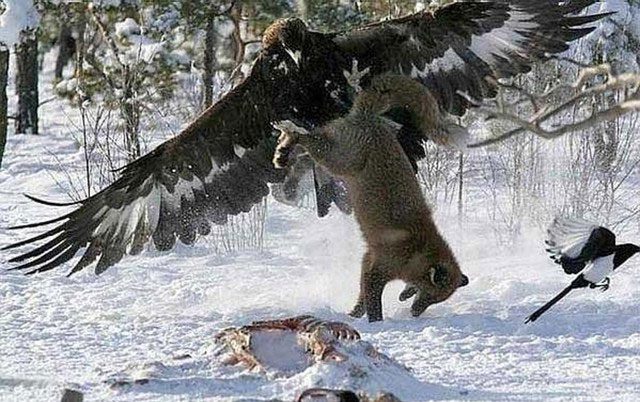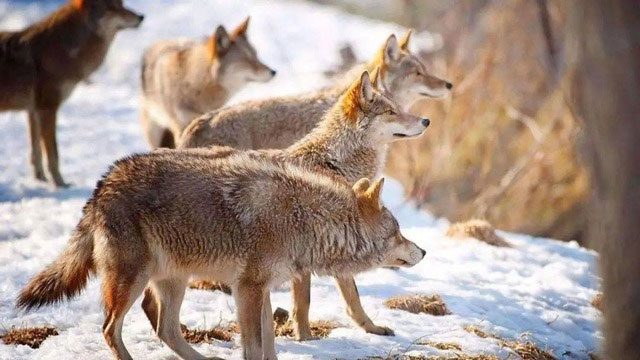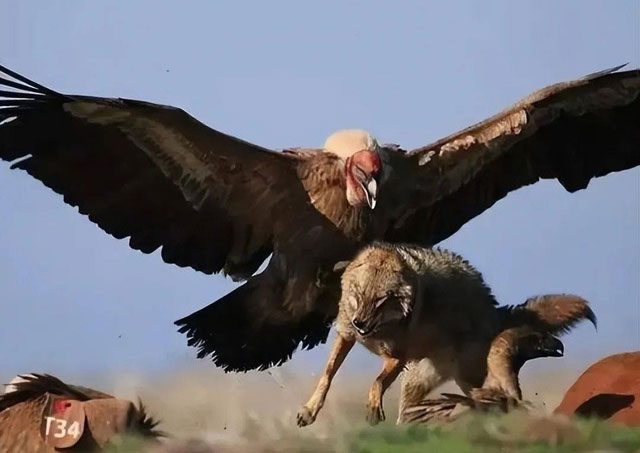The Golden Eagle is a powerful bird of prey with sharp talons and a keen beak, as well as exceptional eyesight. They typically inhabit mountainous areas or cliffs and survive by hunting small animals. However, on the plains, competition is more intense, and the Golden Eagle must defend its territory and food sources.
When a Golden Eagle detects a pack of wolves approaching its territory, it will immediately take action and swoop down on the wolves to assert its dominance and strength, warning them not to encroach on its territory.
In the grasslands, food is not always easy to find, and the Golden Eagle expends a lot of energy to maintain its flight and hunt. When a pack of wolves attempts to steal the Golden Eagle’s prey, the eagle will use its strength and skills to protect its food source, ensuring it has enough nutrition to survive and reproduce.
The behavior of the Golden Eagle swooping towards the wolf pack is also a means of ensuring its own survival and reproduction. In nature, the ‘law of the jungle’ is an eternal rule; the Golden Eagle must display its power and majesty to survive in a fiercely competitive environment. By fighting off the wolves, the Golden Eagle can not only protect its territory and food sources but also demonstrate its dominance over its domain.

The Golden Eagle uses its superior flying ability to hunt for prey. They have very sharp eyesight and can detect animals on the ground from great distances in the air. Upon spotting prey, the Golden Eagle will soar in the sky, waiting for the right moment. Because the Golden Eagle flies fast and is highly maneuverable, other animals find it difficult to catch up, giving it a significant advantage.
The Golden Eagle uses its sharp talons to grasp its prey. Its talons are long, sharp, and possess a strong grip. Once the Golden Eagle identifies its target, it swiftly descends and uses its talons to seize the prey. The talons of the Golden Eagle can capture not only small animals but also larger prey such as rabbits, birds, and even wolves.
After capturing its prey, the Golden Eagle will quickly return to its nest – they typically nest in tall trees or on cliffs.

According to research, the Golden Eagle has significantly stronger eyesight than humans and can easily detect small animal trails from afar. This excellent vision allows the Golden Eagle to quickly catch prey on the vast plains, even small mammals hiding in the grass.
Compared to wolves, Golden Eagles can locate their prey faster due to their powerful eyesight, leading to a higher success rate in hunting. When hunting, the Golden Eagle often swoops down or glides through the air to attack its prey at high speed. Upon finding its target, the Golden Eagle will quickly descend and use its sharp talons and strong beak to subdue the prey.
The Golden Eagle can soar freely over vast grasslands, covering a large area, which makes it easier for them to spot their prey. At the same time, the Golden Eagle has a strong desire to claim its territory and will actively defend its territory from other predators. This territorial awareness also allows the Golden Eagle to better protect its prey, further enhancing its advantage as a natural predator of wolves.

The wolf pack, though fierce, seems powerless against the Golden Eagle in the sky. The sharp talons and aggressive attacks of the Golden Eagle make it difficult for the pack of wolves to resist, so they rely on collective action to combat this threat. When a Golden Eagle soars overhead and prepares to dive, the entire wolf pack quickly forms a defensive circle, making it hard for the eagle to find an opening to attack.
The wolves will cooperate and use a collective ambush to fight against the Golden Eagle, leveraging their numerical advantage to thwart the predator’s attack. In addition to collective actions, wolves prioritize the protection of their pups. The mother wolf will lead her pups to safety, away from the reach of the Golden Eagle.

In nature, wolves are often regarded as powerful predators and usually pose a threat to other animal groups, especially those that are relatively weaker. Therefore, when the Golden Eagle chooses to attack wolves, this action can be seen as a means of protecting other animal populations and helping to maintain ecological balance.
The aggressive behavior of the Golden Eagle can effectively weaken the threat posed by wolves and reduce their predation pressure on other animal species, creating a more harmonious and stable ecosystem.
The significance of the Golden Eagle’s attack on the wolf pack also conveys a positive energy in nature. As a top predator, the Golden Eagle showcases the wonders and beauty of nature through its courage and exceptional hunting skills. They not only amaze but also inspire people with the vitality and intelligence of the natural world.




















































